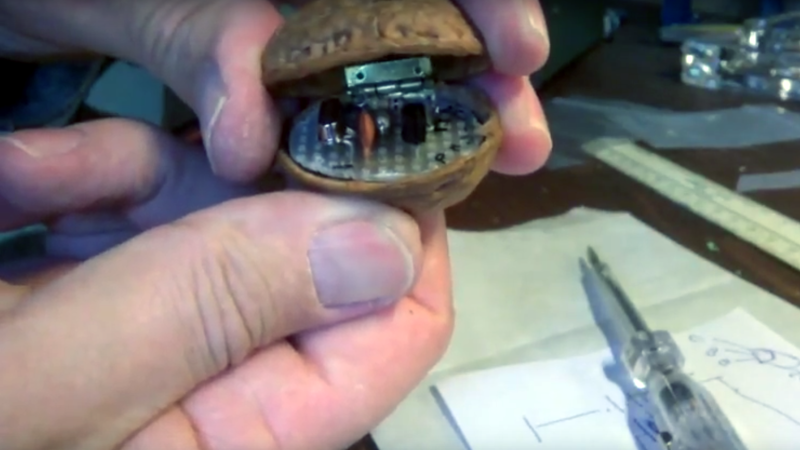What’s the minimal BOM for a working amateur radio transmitter? Looks like you can get away with seven parts, or eight if you include the walnut. You’ve got to have a walnut.
Some hams really love the challenge of QRP, or the deliberate use of low-power transmitters to provide a challenge to making long-distance contacts. We’ve covered the world of QRP before and noted that while QRP rigs don’t throw a lot of power, it doesn’t mean that they need to be simple. Some get quite complex and support many different modulation schemes, even digital modes. With only a single 2N3904 transistor, [Jarno (PA3DMI)]’s tiny transmitter won’t do much more than send Morse using CW modulation, but given that it’s doing so from inside a walnut shell, we have no complaints. The two halves of the shell are hinged together and hold a scrap of perfboard for the simple quartz crystal oscillator. The prototype was tuned outside the shell, and the 9-volt battery is obviously external, but aside from that it’s nothing but nuts.
We’d love to see [Jarno] add a spring to the hinge and contacts on the shell halves so no keyer is required. Who knows? Castanet-style keying might be all the rage with hams after that.

















Definitely needs to make the walnut halves the “key”
Squirrels will boost the ranks of amateurs worldwide. They love to chew the rag and hang out. They already have location, just need power.
The movement of the walnut halves could be harnessed both for keying and for generating power.
But you should be careful not to crack it.
That’s an awesome little transmitter! Love the nutty enclosure!
If you like that little rig then you might like this one as well. The KeychainQRP HF Transmitter. It’s also powered by 9v but it’s even smaller, you can keep it attached to your car keys, has its own built in micro straight key, SMA antenna connector, comes in 5 HF ham band options and even has a built in mini morse code cheat sheet chart for those still learning CW: http://bit.ly/KeychainQRP
I already have a keychain QRP transmitter. It operates at 433.92 MHz in digital mode, and I can even use it to open my car :-)
That’s hilarious! ????
+1 !
also, I think there’s this website, I think it’s called hackaday, where there’s a huge rage going on over this small QRP thing with less than eight components. It speaks a strange digital mode (some might call it IEEE802.11) and goes by the name of ESPsomething.
I imagine the NSA has something smaller, so a walnut tree could be bugged.
lol. Yeah. Secret services had bugs smaller than that when crystal radios came up.
Perfect spy gear for Secret Squirrel.
Guess which shell the radio is under and win a QRP-Doll.
No, wait, there has to be a “Dead-Bug in my walnut” joke somewhere.
you can deadbug my walnut
I wonder if you could take a wafer and instead of powering it by the coil power it by a coin cell, then you have a very very tiny transmitter, although I’m not sure what range you would get that way.
It would be a hack though.
I wonder what could fit inside of a coconut! Nice job.
Said Gilligan to the Professor.
That is just plain nuts!
You guy rock ! Go nuts :-)
PA3DMI – Jarno
There is at least one keychain transmitter design for ham HF (not 433 MHz), I remember such a one transistor *transceiver* on 80 meters (using an old-timey high impedance earpiece when receiving) in one of the QRP books available at the ham store, http://www.universal-radio.com/catalog/books/1122.html The project was from a guy in Tennessee, if I remember right.
Then there’s the Gnat-1 single transistor transceiver (PDF), http://home.earthlink.net/~christrask/Gnat%2040.pdf
Handmade Etsy HF keychain transceivers for different bands, https://www.etsy.com/shop/QuirkyQRPHamRadios
I lied, those pre-made keychain ham HF things at Etsy are transmitters, but they have a transmit key on them, not a house or car key.
Small detail “condensator is called a capacitor in het angelsaksisch” Mooi gemaakt btw.
The kid in me would love to build this and send it in a balloon across the Atlantic to the UK or someplace. Maybe someone would help continue it on around the world.
Could you possibly use a 3 x 3v button cells to fit inside the walnut, or maybe 2 and adjust it to run on 6volts or is there too much voltage drop across the xtal?
Imagine if it was SMD. then you could fit a IRF510 PA in there??? Maybe possibly??
either way its a problem that you seem to have cracked!
its the mutts nutts! LOL
72 GØNMY
One “Feature” of this transmitter is its ability to operate on multiple bands simultaneously :-(
When I was in school (1980ies), I built a small FM transmitter, with just glue and solder, no perfboard, which would easily have fitted into the walnut (about the size of a sugar cube). Of course it was not really “good”, bad microphone sensitivity or stability and very low power with it’s 1,5V watch cell. Probably you could have used it in CW :-)
But concerning this project, I would use one of the small 12V batteries, it could fit into the nut. Or a stack of button cells. It would just be nice to get rid of the external power source.